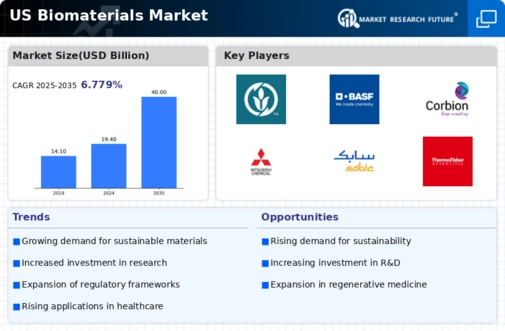The competitive landscape of the US Biomaterials Market is characterized by rapid innovation, a growing focus on sustainability, and increasing adoption across various industrial sectors. The industry encompasses a range of materials derived from renewable biological sources, offering viable alternatives to traditional petroleum-based products. As environmental concerns intensify and regulatory demands for sustainable products increase, companies are positioning themselves strategically to capture market share by offering innovative biomaterials that meet both performance and sustainability standards.
Competitive dynamics are influenced by factors such as technological advancements, partnerships, funding for research and development, and an emphasis on circular economy practices. The market is filled with players that continuously strive to enhance their product offerings and improve their supply chains in response to consumer and industrial needs.
NatureWorks stands out in the US Biomaterials Market primarily through its development of Ingeo biopolymer, which is produced from renewable plant materials. The company leverages its strong research capabilities and commitment to sustainability to position itself as a leader in the production of bio-based materials. NatureWorks benefits from a robust manufacturing infrastructure and strategic alliances with suppliers and manufacturers to enhance its market presence. This strong foundation enables NatureWorks to serve various applications, including packaging, textiles, and consumer goods, thus leading to an expanding customer base in the US.
The emphasis on environmentally friendly manufacturing processes and the ability to deliver high-performance products are critical strengths that help NatureWorks maintain its competitive edge in the market.
BASF plays a significant role in the US Biomaterials Market by offering a diverse range of products that cater to different applications, including biodegradable polymers and bio-based products. The company emphasizes innovation and has a wide array of research initiatives aimed at developing advanced biomaterials solutions tailored to specific industry needs. BASF's strengths lie in its extensive supply chain and manufacturing capabilities, allowing for efficient production and distribution of its biomaterial products throughout the US. Additionally, BASF actively engages in mergers and acquisitions to expand its product portfolio and strengthen its market position.
The synergy created through these strategic maneuvers allows BASF to not only enhance its product offerings but also tap into new market opportunities, thereby solidifying its presence in the competitive landscape of the US Biomaterials Market.



















